In this chapter, we will study how to create a template in Joomla.
Step (1) − Create a folder called MyFirstTemplate inside your Joomla → Templates folder. Inside MyFirstTemplate folder, create 2 more folders named as images and CSS to save all the images and CSS files.
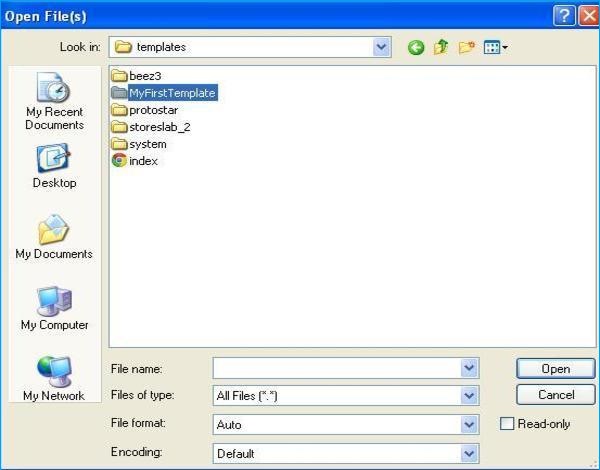 Step (2) − Inside MyFirstTemplate folder, create a file called as templateDetails.xml, without this file the template will not get displayed in Joomla.
Step (2) − Inside MyFirstTemplate folder, create a file called as templateDetails.xml, without this file the template will not get displayed in Joomla.
Step (4) − After creating these two files, login to Joomla and click on Extension → Extension Manager and the following page will get displayed.
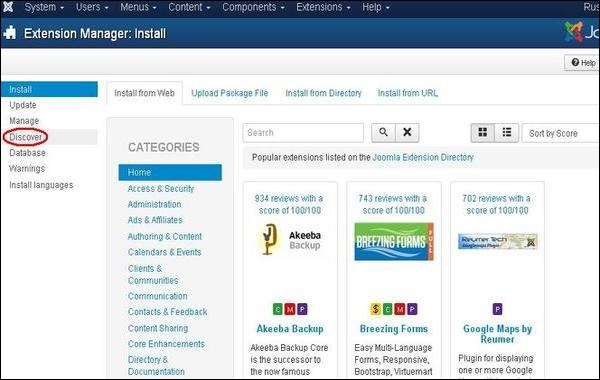 Step (5) − In the above page, click on Discover link, the following page is displayed.
Step (5) − In the above page, click on Discover link, the following page is displayed.
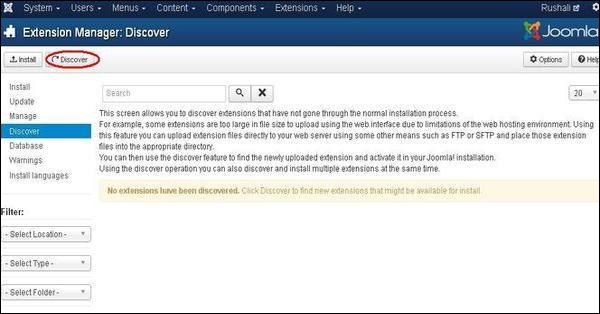 Step (6) − Next, click on the Discover button to discover the new created template as shown below.
Step (6) − Next, click on the Discover button to discover the new created template as shown below.
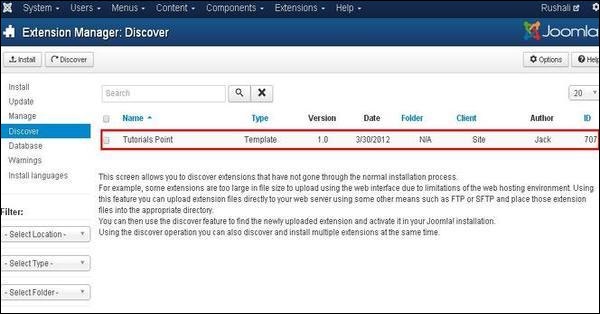 Step (7) − Click on the checkbox to select the template and click on Install button to install the template in Joomla.
Step (7) − Click on the checkbox to select the template and click on Install button to install the template in Joomla.
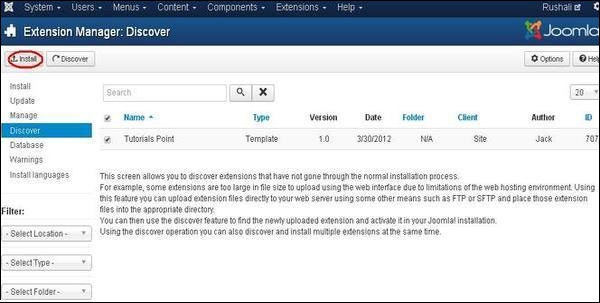 Step (8) − After installing template you can view your new created template by clicking on Extension → Template Manager. You will see your new created template is listed as shown below.
Step (8) − After installing template you can view your new created template by clicking on Extension → Template Manager. You will see your new created template is listed as shown below.
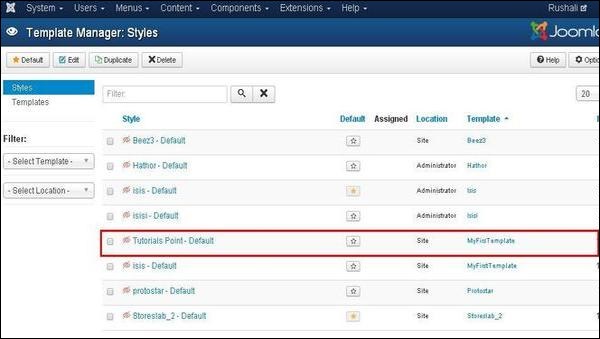
Creating Templates
Following are the simple steps to create templates in Joomla −Step (1) − Create a folder called MyFirstTemplate inside your Joomla → Templates folder. Inside MyFirstTemplate folder, create 2 more folders named as images and CSS to save all the images and CSS files.
 Step (2) − Inside MyFirstTemplate folder, create a file called as templateDetails.xml, without this file the template will not get displayed in Joomla.
Step (2) − Inside MyFirstTemplate folder, create a file called as templateDetails.xml, without this file the template will not get displayed in Joomla.templateDetails.xml
<?xml version = "1.0" encoding = "utf-8"?> <extension version = "3.0" type = "template"> <name>Tutorials Point</name> <creationDate>2015-06-13</creationDate> <author>Tutorials Point</author> <authorEmail>tutorials@example.com</authorEmail> <authorUrl>http://www.example.com </authorUrl> <copyright>Jack 2015</copyright> <license>GNU/GPL</license> <version>1.0.2</version> <description>My First Template</description> <files> <filename>index.php</filename> <filename>templateDetails.xml</filename> <folder>images</folder> <folder>css</folder> </files> <positions> <position>breadcrumb</position> <position>left</position> <position>right</position> <position>top</position> <position>user1</position> <position>user2</position> <position>user3</position> <position>user4</position> <position>footer</position> </positions> </extension>
Details of the code
- <files> − It contains the available files and folders in MyFirstTemplate folder.
- <folder> − It takes the entire available folders in MyFirstTemplate folder.
index.php
<?php defined( '_JEXEC' ) or die( 'Restricted access' );?> <!DOCTYPE html> <html xmlns = "http://www.w3.org/1999/xhtml" xml:lang = "<?php echo $this->language; ?>" lang = "<?php echo $this->language; ?>" > <head> //head section <jdoc:include type = "head" /> <link rel = "stylesheet" href = "<?php echo $this->baseurl ?>/templates/system/css/system.css" type = "text/css" /> <link rel = "stylesheet" href = "<?php echo $this->baseurl ?>/templates/system/css/general.css" type = "text/css" /> <link rel = "stylesheet" href = "<?php echo $this->baseurl ?>/templates/<?php echo $this->template; ?>/css/template.css" type="text/css" /> </head> <body> //body section <jdoc:include type = "modules" name = "top" /> <jdoc:include type = "component" /> <jdoc:include type = "modules" name = "bottom" /> </body> </html> ?>
Details of the code
<?php defined( '_JEXEC' ) or die( 'Restricted access' );?> <!DOCTYPE html> <html xmlns = "http://www.w3.org/1999/xhtml" xml:lang = "<?php echo $this->language; ?>" lang = "<?php echo $this->language; ?>" >This code is used to tell the browser which type of html page is being used and begins the HTML document by describing the language used in the website.
<head> //head section <jdoc:include type = "head" /> <link rel = "stylesheet" href = "<?php echo $this->baseurl ?>/templates/system/css/system.css" type = "text/css" /> <link rel = "stylesheet" href = "<?php echo $this->baseurl ?>/templates/system/css/general.css" type = "text/css" /> <link rel = "stylesheet" href = "<?php echo $this->baseurl ?>/templates/<?php echo $this->template; ?>/css/template.css" type = "text/css" /> </head>These lines are used to link the various stylesheets for the template in Joomla.
<body> //body section <jdoc:include type = "modules" name = "top" /> <jdoc:include type = "component" /> <jdoc:include type = "modules" name = "bottom" /> </body>Here in the body section, the jdoc is used to include the output in Joomla from some parts of Joomla system. The name = "top" is used to set the menu at the top.
Step (4) − After creating these two files, login to Joomla and click on Extension → Extension Manager and the following page will get displayed.
 Step (5) − In the above page, click on Discover link, the following page is displayed.
Step (5) − In the above page, click on Discover link, the following page is displayed.  Step (6) − Next, click on the Discover button to discover the new created template as shown below.
Step (6) − Next, click on the Discover button to discover the new created template as shown below. Step (7) − Click on the checkbox to select the template and click on Install button to install the template in Joomla.
Step (7) − Click on the checkbox to select the template and click on Install button to install the template in Joomla. Step (8) − After installing template you can view your new created template by clicking on Extension → Template Manager. You will see your new created template is listed as shown below.
Step (8) − After installing template you can view your new created template by clicking on Extension → Template Manager. You will see your new created template is listed as shown below.
Toolbar
Following are the toolbar options in the Template Manager −- Default − Select the default template.
- Edit − Select the template for editing.
- Duplicate − Duplicate the copy of the selected template.
- Delete − Delete the template for Joomla.

No comments:
Post a Comment